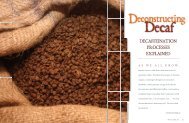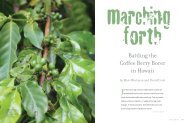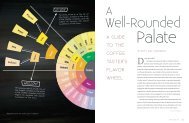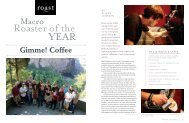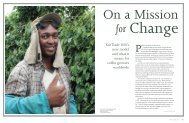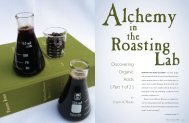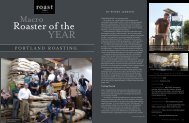Taking ConTrol: PiD seTTings - Roast Magazine
Taking ConTrol: PiD seTTings - Roast Magazine
Taking ConTrol: PiD seTTings - Roast Magazine
You also want an ePaper? Increase the reach of your titles
YUMPU automatically turns print PDFs into web optimized ePapers that Google loves.
ta k i n g<br />
CONTROL<br />
PID Settings<br />
and<br />
<strong>Roast</strong>ing Controls<br />
by<br />
Ter r y Da v i s<br />
w it h re s e a rc h by<br />
Pa u l Ribich<br />
For years, the question of roaster controls has been a<br />
source of contention within the modern coffee roasting community.<br />
How much control is too much (the law of diminishing returns?),<br />
and how little is too little (do you like flying by the seat of your<br />
pants?). These are just some of the questions that are batted back<br />
and forth by coffee roasters. Moreover, questions about control<br />
often lead to discussions that get to the heart of coffee roasting—<br />
is it a creative art or a systematic science?<br />
continued on page 54<br />
March | April 2005 53
<strong>Taking</strong> Control: PID settings ( continued)<br />
Professional roasters and hobbyists<br />
alike have debated control questions ad<br />
nauseam. It seems to matter little whether<br />
an adherent to one school or another is<br />
working on a tabletop or a four-bagger;<br />
there are proponents of each approach in<br />
every roaster size category.<br />
Often, the discussion degenerates<br />
into a West Side Story-style face-off of<br />
backhanded compliments, posturing and<br />
Free Info #116<br />
outright demagoguery. Many times those<br />
with the loudest voices, longest careers or<br />
most impressive résumés win by default or<br />
through intellectual intimidation. The craft<br />
adherents accuse the “technology geeks” of<br />
being trapped in a futuristic fantasy where<br />
HAL will one day handle all aspects of the<br />
roasting process. Likewise, proponents of<br />
the coffee roasting as pure science school<br />
accuse the craft roasters of being neo-<br />
Luddites attempting to bar Darwin from<br />
entering the roastery door. Although<br />
it can be quite entertaining to listen<br />
to hardcore partisans of both schools<br />
espouse their orthodoxy, it is rarely, if<br />
ever, very informative.<br />
Proportional Integral Derivative<br />
Controllers<br />
One of the biggest control discussions<br />
in the coffee industry lately has<br />
revolved around proportional integral<br />
derivative (PID) controllers: logicbased<br />
controllers that allow the user<br />
to input temperature set points, and<br />
influence the logic. The PID’s ability to<br />
control heating functions is well known<br />
but not well understood by most coffee<br />
professionals. Happily, roasters and<br />
baristas alike are trying to figure out<br />
how to use these tools to better control<br />
their respective processes.<br />
Most new coffee roasters delivered<br />
today have at least a simple PID<br />
controller installed as standard<br />
equipment, and many come with fairly<br />
sophisticated PID profiling controllers.<br />
Most roaster operators, however, have no<br />
clue as to what PID stands for or, more<br />
importantly, how to use this technology<br />
to their benefit.<br />
Those who don’t understand<br />
the technology may use their PID<br />
controllers for set point controlling, or<br />
simply as digital temperature readers.<br />
When roasters use a PID as a set point<br />
controller, they input a set point in<br />
their controller and allow the bean or<br />
air temperature to rise to that point at<br />
which time the controller either sounds<br />
an alarm, shuts off gas to the burner<br />
or both. Although this can work very<br />
well and is a great improvement in<br />
controllability, repeatability and safety<br />
from the stopwatch and trier systems of<br />
the past, it is in fact an underutilization<br />
of a PID controller.<br />
A properly set PID controller, with<br />
a controllable gas train, can help make<br />
coffee roasting a much more exact and<br />
repeatable process, thereby freeing the<br />
roaster to work on other elements of<br />
quality control (namely green coffee<br />
and blending) that are so essential in<br />
the creation and sustainability of great<br />
coffee.<br />
54<br />
roast
Not all roasters will choose to use PID controllers for the roasting<br />
process, and that is their choice, as it should be. However, in order to<br />
make a valid choice, a roaster must understand<br />
existing technologies; what they can and<br />
cannot do for their businesses. A choice made<br />
without evaluating all available information is<br />
a gamble, and why gamble with good coffee?<br />
This article attempts to clarify some of the<br />
mystery that surrounds PID controllers and to<br />
look at what one roastery was able to do with<br />
one roaster in one installation.<br />
PID Basics<br />
So what does PID mean? What is a PID<br />
controller? What is the difference between a<br />
PID controller and PID profiling controller?<br />
PID logic control is used in many of the<br />
better off-the-shelf digital controllers (Watlow,<br />
Omron, Honeywell, Siemens, etc.) and most,<br />
if not all, proprietary coffee roasting control<br />
systems produced by roaster manufacturers.<br />
PID controllers make mathematical calculations to help keep<br />
the actual temperature as close as possible to a desired set point<br />
temperature. In the case of coffee roasting, the set points are<br />
generated along a positive sloping curve. If the PID settings in a<br />
PID array are incorrect, then the system will either be constantly<br />
running to catch up to the desired curve, or<br />
constantly overshooting and undershooting<br />
as the controller attempts to bring the actual<br />
temperature to the set point.<br />
A fully functional PID controller will<br />
generate set points regardless of whether<br />
the PID settings are correct (See Graphs<br />
1 & 2, pages 58–59). For the roaster, the<br />
trick is to find the correct PID settings for<br />
their roaster in its installation. The proper<br />
use of PID controllers is the next logical<br />
step up from manually profiling coffee<br />
through manipulation of the existing time<br />
and temperature curve. A roaster’s existing<br />
time and temperature curve is the curve<br />
that naturally occurs when a single piece of<br />
roasting equipment in a set environment is<br />
roasting a particular coffee, and no changes<br />
are undertaken by the operator until the end<br />
of the roast.<br />
So the question becomes: how do you find the correct PID<br />
settings for your roaster and its control system? For most roasters,<br />
continued on page 56<br />
Free Info #163<br />
March | April 2005 55
<strong>Taking</strong> Control: PID settings ( continued)<br />
using a PID controller with a ramping (ramp and soak) or<br />
profiling function, the PID settings will be different than those<br />
used by most proprietary roasting programs. In most cases, offthe-shelf<br />
controllers will require a slightly more aggressive P<br />
value and I value, while the D should be set to zero for coffee<br />
roasting. Many PID profiling controllers contain auto-tune<br />
functions that attempt to assist with PID settings. It has been<br />
our experience however, that auto-tuning functions do not work<br />
well for setting PID values for the coffee roasting process.<br />
To properly set PID settings, it is imperative to understand<br />
what each part of the PID acronym means and its effect on the<br />
logic used to control the heat input:<br />
Free Info #190<br />
Free Info #144<br />
Free Info #170<br />
(P) P, or more accurately, proportional, is the part of the logic<br />
that dictates how aggressively a system will try to acquire the set<br />
point. The larger the P, the faster the controller will ramp up<br />
temperature. If, for example, you set a P value of 1, it will reduce<br />
heat input as it climbs toward the curve so that it will gradually<br />
intersect. If the P is 50, the output will be more aggressive. The<br />
output will remain at 100 percent until very nearly reaching the<br />
point of intersection.<br />
In other words, P defines the distance at which your foot<br />
comes off the gas as you approach a line of traffic. Remember, the<br />
larger the P, the more aggressive the control system and gas train<br />
are (See Chart 1). If P is too aggressive, it will supply energy up<br />
to the point of intersection and then drop immediately to zero<br />
percent output. In a process like coffee roasting where much<br />
of the energy is retained and the product itself will begin to go<br />
exothermic, an aggressive P will often overshoot and, depending<br />
on where in the roasting process this occurs, may eventually fall<br />
behind the curve, causing the control system to constantly chase<br />
the desired profile curve (See Graph 1, page 58).<br />
(I) If P is your gross adjustment on your control system,<br />
then I is the fine adjustment. I, or integral, is the value inputted<br />
to raise the temperature slightly so as to attain set point: the gain.<br />
I values work in an inverse relation to the P values. The larger<br />
the I, the smaller the gain, the smaller the I, the larger the gain<br />
(See Chart 2). Because I is the fine adjustment, I should not<br />
be adjusted until the P value is set. Too much I (low number)<br />
will cause the system to be unstable around the set point, while<br />
too little I will lead to proportional droop, when P is correctly<br />
adjusted (See Graph 2, page 59). Good control of the process is<br />
a function of PI.<br />
(D) Finally, there is the D, or derivative, value. Derivative<br />
is the value that is used to dampen oscillations about a set<br />
point. It is in essence a “super fine” or squelch adjustment. In<br />
our experience, if a controller utilizes a bean probe for actual<br />
temperature control, then there is no need for a derivative value.<br />
However, if a roaster is using environment temperature to<br />
control the process, then a derivative value may be desirable.<br />
The graphs used in this article rely on bean temperature<br />
as the temperature to be used in controlling the function;<br />
environment temperature is logged only and not used for any<br />
calculations, and therefore the graphs have a D value of zero.<br />
Charts 1 and 2 list different P and I values and their relative<br />
effects on output.<br />
56<br />
roast
Let’s first look at P settings.<br />
P VALUE<br />
I VALUE<br />
Temperature difference<br />
when output starts to be<br />
less than 100%<br />
1 0 99 degrees<br />
10 0 10 degrees<br />
20 0 5 degrees<br />
30 0 3.4 degrees<br />
Chart 1<br />
What does this mean? If you look at the temperature<br />
difference value of a P of 20, the difference is five degrees, which<br />
means that the output calculated will be 100 percent if the<br />
temperature difference is five, 50 percent when the difference<br />
is 2.5 and zero percent when the difference is zero. So over the<br />
five degrees difference, the output will be scaled anywhere in<br />
between.<br />
Now hold P constant and add different I values.<br />
Free Info #156<br />
P VALUE<br />
I VALUE<br />
Output percentage<br />
at 2.5 degrees difference<br />
20 0 50%<br />
20 20 50.09%<br />
20 10 50.18%<br />
20 0.5 53.6%<br />
Chart 2<br />
This shows what kind of gain the I value provides. The<br />
output calculated is not as simple as shown here. The complete<br />
calculation is based on elapsed time between calculations,<br />
how the temperature is responding to the output, how fast the<br />
temperature was rising/falling, etc. PID calculations are not<br />
easily understood. However, hopefully this will provide you with<br />
better insight as to what changing the settings will accomplish.<br />
Free Info #187<br />
A Test Flight<br />
So much for the science (or attempted explanation thereof).<br />
What are the practical effects of PID settings in programmable<br />
controllers, and how to read and set them?<br />
As most experienced roasters know, the actual act of roasting<br />
coffee is a fairly simple undertaking. Turning the coffee from a<br />
certain shade of green to a certain shade of brown seldom rises<br />
to the level of rocket science.<br />
That said, choosing which beans to roast to what level and<br />
the profile to be followed to bring the most out of each and every<br />
coffee, each and every time, can sometimes rise to the level of<br />
pure magic. Like magic, consistent roasting takes an intimate<br />
continued on page 58<br />
Free Info #134<br />
March | April 2005 57
<strong>Taking</strong> Control: PID settings ( continued)<br />
GRAPH 1<br />
knowledge of the equipment used, a high degree of technical<br />
excellence, continuous practice and an open mind. Accepting<br />
technological change takes an open mind.<br />
To test and set our PIDs, we did extensive research on a 15-<br />
kilo Ambex coffee roaster retrofitted with the Profile Plus DCQ<br />
system. The equipment operates on natural gas, has a total exhaust<br />
length of 27 feet with (1) 90-degree angle at the base of the roaster<br />
and ending in a “no-loss”<br />
stackhead. All roasts were<br />
conducted in a hands-off<br />
manner (that is, once PID<br />
settings were made and the<br />
roast started, there was no<br />
human intervention). All<br />
roasts were subsequently<br />
cupped for quality. All<br />
data (including all roasts<br />
conducted since October<br />
1, 2004) have been kept<br />
and are reviewed against<br />
subsequent changes in<br />
atmosphere, green coffee<br />
crop and periodic roaster<br />
maintenance. Much of the<br />
initial PID research was<br />
compiled by Paul Ribich<br />
for the SCAA’s upcoming<br />
Coffee <strong>Roast</strong>er’s Handbook.<br />
The graphs used in this<br />
article are actual roasts<br />
taken from the data log<br />
files and shown in the log<br />
reviewer format.<br />
Graphs 1 and 2 are<br />
actual examples of what<br />
happens when PI settings are incorrect. Graph 3 (page 60) is<br />
an example of correctly set PI values for a roasting process. The<br />
following graphs display three data lines: desired profile (set point)<br />
in blue, environment temperature path in orange and actual bean<br />
temperature profile in green (graph legends on right of graph).<br />
In Graph 1, it is easy to see what occurs when a P value is<br />
too large. The overly aggressive proportional function causes the<br />
Free Info #151<br />
58<br />
roast
actual temperature (bean<br />
temperature) or green line<br />
to overshoot the desired<br />
profile/set point curve<br />
(blue and purple) three<br />
successive times. Not only<br />
is the bean temperature<br />
generally above the<br />
desired profile curve, it has<br />
produced its own distorted<br />
(and undesirable) profile<br />
curve. In fact, the green<br />
line appears to almost<br />
“bounce” from line to<br />
line as time progresses.<br />
The correction to this<br />
problem is to reduce the P<br />
value until overshooting is<br />
alleviated.<br />
In Graph 2, the gross<br />
overshooting or bouncing<br />
of the green line has<br />
been virtually eliminated.<br />
However, upon closer<br />
inspection, it is clear that<br />
the bean temperature,<br />
while maintaining the<br />
shape of the desired profile<br />
curve, consistently tracks below the blue and purple of the desired<br />
profile. While many roasters would be very pleased with a time and<br />
temperature curve as close to target as this, it is actually possible<br />
to shift or “gain” this droop away by adjusting the I setting. What<br />
is needed in this example is a more reactive I. A faster integrating<br />
action can be acquired by using a smaller I value. The correct I<br />
value will, in effect, offset the droop of a correctly set P.<br />
GRAPH 2<br />
Eureka! Graph 3 shows what happens when PI values are<br />
inputted correctly. Set Point and Bean Probe lines are married up<br />
from start to finish. The Profile line is acquired at Hold Temperature,<br />
and all three lines track consistently from that point forward. Not<br />
only is the desired roast time and temperature reached (within<br />
a five-second window), but the integrity of the desired profile is<br />
continued on page 60<br />
Free Info #128<br />
March | April 2005 59
<strong>Taking</strong> Control: PID settings ( continued)<br />
GRAPH 3<br />
GRAPH 4<br />
60<br />
roast
maintained throughout the entire roasting<br />
process.<br />
Kathi Z’s Magic Trick<br />
The final graph, Graph 4, is of a one-pound<br />
roast in a 15-kilo roaster. Kathi Zollman,<br />
roast master for New Harmony Coffee &<br />
Tea, by experimenting with PI settings,<br />
consulting Paul the engineer, and adjusting<br />
initial drop temperature, was able to get a<br />
one-pound roast to follow a pre-set profile,<br />
a feat that even the manufacturer thought<br />
impossible. The inability to control a small<br />
fractional batch in a drum roaster has<br />
long been a problem, even for experienced<br />
roasters. To get a small batch to actually<br />
follow a large-batch profile was considered<br />
pure magic.<br />
A closer inspection reveals how the<br />
environment temperature (burner) was<br />
constantly adjusting to keep the bean<br />
temperature on the desired profile.<br />
Although this roast, like the others<br />
shown, was accomplished with a handsoff<br />
technique, it required an experienced<br />
roaster utilizing all her talents to ascertain<br />
and input the correct settings. Such things as<br />
total energy present at start of roast; energy<br />
acceleration and bleed rates; responsivity of<br />
controls; accuracy of temperature readings<br />
(bean temperature); changes in conduction<br />
and convection ratios; and the green coffee<br />
itself (hard bean, soft bean, old crop, new<br />
crop) all played a part in determining<br />
the PID settings and the desired profile.<br />
Like a good magician, Kathi just made it<br />
look easy. (As an aside, the coffee cupped<br />
admirably as well.)<br />
Expanding the Realm of Possibilities<br />
As an industry, we are entering a time when<br />
new control technologies are becoming<br />
more widely available and cheaper. This,<br />
coupled with the exchange of information<br />
being fomented by the rise of the <strong>Roast</strong>er’s<br />
Guild, online coffee roasting bulletin<br />
boards, and more technically oriented<br />
and focused trade journals, are increasing<br />
the level of professionalism of the specialty<br />
coffee industry and expanding the realm<br />
of possibilities for those of us who have<br />
committed our livelihood, and lives, to this<br />
industry. As to the question of whether<br />
coffee roasting is art or science, it has<br />
always been both. A good roaster needs the<br />
intuition of an artist, the work ethic of a<br />
craftsman and the inquiring intellect of a<br />
scientist to truly become a master.<br />
Terry Davis is the president of Ambex, Inc.,<br />
an equipment manufacturer and distributor, and<br />
New Harmony Coffee & Tea, a retail/roastery<br />
in Clearwater, Fla. He is also is a member of the<br />
Tampa Bay Chapter of the Council on Foreign<br />
Relations, the <strong>Roast</strong>ers Guild and the American<br />
Civil Liberties Union (ACLU).<br />
Paul Ribich is the process engineer for Ambex,<br />
Inc. He has a BS in mechanical engineering and<br />
an AAS in mechanical engineering technology and<br />
is a former team leader of advanced processes at<br />
Watlow Electric’s Temperature Sensor Division.<br />
Paul is a member of the <strong>Roast</strong>ers Guild who<br />
changes his own oil and is an avid woodworker.<br />
Hands-On Control<br />
v<br />
Free Info #161 Free Info #146<br />
Free Info #110<br />
March | April 2005 61
<strong>Taking</strong> Control: PID settings ( continued)<br />
HANDS-ON CONTROL<br />
b y Ka t h i Zo l l m a n<br />
I consider myself an experienced roaster. After seven years of<br />
roasting, I’m comfortable with my baseline knowledge and my<br />
understanding of the roasting process. However, I’m finding that<br />
today’s coffee roasting environment is one of constant change.<br />
The craft is being immersed with science, offering us new ways to<br />
unravel the mysteries of roasting, such as what really happens to<br />
the green coffee during the roasting process.<br />
The primary concepts I learned in Coffee <strong>Roast</strong>ing 101 are<br />
important in understanding the fundamentals of the roast, and<br />
it’s this base knowledge that gives me a level of comprehension<br />
as I turn my focus to new ideas and concepts of control like PID<br />
controllers.<br />
For years, I used a digital timer and temperature probe to<br />
achieve consistency in my roast profiles and had satisfactory<br />
results. But I found that I had to move out of my comfort<br />
zone of familiar techniques and<br />
terminology to learn the new skill<br />
of controlling the roast with PIDs.<br />
While this was an intimidating<br />
endeavor, my newfound roasting<br />
skills and working knowledge of<br />
PID controllers (although limited)<br />
has been rewarding and exciting.<br />
I feel that learning the scientific<br />
language and mastering the basics<br />
of PID controllers provided me<br />
with a new level of expertise. When<br />
I combine this new science with my<br />
craft, I have a new roasting tool that<br />
helps achieve a controlled path to<br />
the completion of each and every<br />
roast.<br />
Today, I control my roaster<br />
environment and the manner in which my roasts progress to the<br />
desired drop point through the logic of the PID controls. This<br />
allows me to look beyond time and temperature as the main<br />
components of the roast profile. With the PID, the S-curve<br />
becomes my tool for discovering the best path to a desired roast.<br />
To determine the most desirable roast profile, I cup various<br />
profiles of the same coffee roasted to the same degree. I alter the<br />
S-curve of each trial roast for an aggressive start or a gentle curve,<br />
for a shorter or longer rest period. When I cup the varying profiles<br />
against one another, I find that the path taken to the drop point<br />
changes the cup characteristics of each coffee, that the path itself<br />
is as critical as the time and final temperature.<br />
Initially I was overwhelmed with the entire concept of control<br />
and PID and, had I been a rookie, it could have been setback for<br />
me. Still, I attempted to break the process down to its simplest<br />
form, making this foreign concept not quite so overwhelming.<br />
I learned that the P of PID means proportional; I find it’s easier<br />
to remember as “power.” The amount of power I apply to the roast<br />
to reach the desired temperature in a pre-designated time frame.<br />
The higher I set the P value, the faster the temperature climbs. If<br />
my initial P settings are too high, the profile path is overshot and<br />
it’s difficult to slow the roast down and regain control.<br />
Once I get the P set so the roasting profile is followed<br />
consistently, I rely on the I, or integral, setting to fine-tune the<br />
roast profile. The I setting provides output boosts to keep the<br />
GRAPH 5<br />
roast on track when the prescribed P setting isn’t maintaining a<br />
smooth path. I settings can be confusing, in that the higher the I<br />
value, the smaller the gain, while a low I value provides a greater<br />
output.<br />
With the control system I have in place, I don’t even have to<br />
use the D, or derivative, setting. I’m able to have enough control<br />
without adding the additional variable.<br />
It takes time and patience to establish accurate PID settings<br />
for desired roast profiles, but once the setting are locked in, very<br />
little additional tuning needs to be done.<br />
Now that I have PID settings in place, I can accurately<br />
duplicate roasts on an ongoing basis. I was surprised to learn that<br />
weather conditions such as barometric pressure and temperature<br />
have less of an effect on the process of the roast than when I<br />
attempted to control the roast manually. To compare my roast<br />
results, I pulled up roast data<br />
graphs of the same coffee profile<br />
roasted on four different days<br />
(one day near freezing, one day<br />
80 degrees, one rainy day and<br />
one overcast day). All four roasts<br />
shadowed one another within<br />
a three-degree spread. Graph 5<br />
shows roast profile data from four<br />
different roast days, all four being<br />
the same coffee and same profile.<br />
The top four thin lines show the<br />
environmental temperature in the<br />
roaster. It’s evident that the system<br />
was working hard to maintain the<br />
profile by looking at the range<br />
in temperatures. The wide lines<br />
represent the prescribed profile<br />
and the actual profiles of the roasts. The lines aren’t clearly<br />
visible, but there are eight lines grouped together showing the<br />
path each roast took.<br />
These graphs support the idea that roasters can replicate<br />
the roast process accurately and consistently with PID controls,<br />
without having to reset perimeters when external variables<br />
change.<br />
I’ve also discovered that PID controllers allow me to use<br />
varying charge weights of green coffee and follow the same<br />
profile, without resetting the roast perimeters. Again, the science<br />
provides consistency for me as a craftsman—within a controlled<br />
roasting environment, I can roast a 12-pound batch of coffee with<br />
the exact profile as a 24-pound batch, with the same results.<br />
I encourage roasters to invest the time and brainpower to<br />
learn how to use PID settings as a tool. It’s habit-forming, and I<br />
find I always want to try something new or make a slight change,<br />
just to see what happens. The applications seem endless to me.<br />
So many roast factors can be changed or experimented with to<br />
roast the perfect coffee and to create a roast style unique to each<br />
roaster.<br />
Kathi Zollman has been in the specialty coffee business for 10<br />
years. In October 2004, she joined the PID team and became the roast<br />
master at New Harmony Coffee & Tea in Clearwater, Fla.<br />
62<br />
roast




